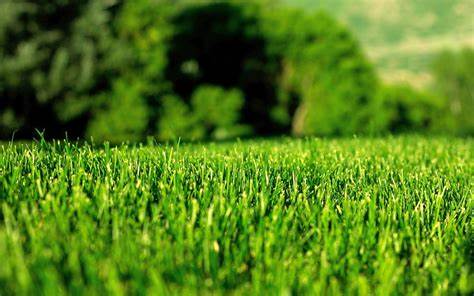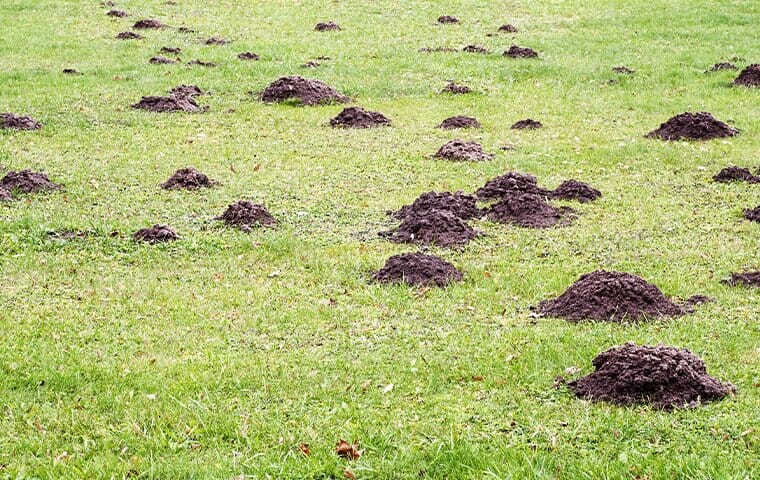Imagine coming home to find your lawn full of tunnels and mounds. This is what happens when moles take over your yard. These small animals can damage your plants, create hazards, and ruin your outdoor space.

Moles are great at digging, tunneling up to 160 feet in one night. They eat a lot, up to 80-100% of their body weight daily. Their hills, up to two feet high, show they’re around, messing up your yard.
This guide will show you how to fight back against moles. We’ll cover how to spot them, stop them, and get rid of them. You’ll learn about mole behavior and how to use removal methods and prevention. We aim to help you take back your lawn from these pests.
Identifying Mole Damage in Your Lawn
Moles are small, burrowing mammals that can cause a lot of damage to your lawn. Knowing how to spot their signs is key to dealing with them. Look for raised ridges or tunnels across your lawn. These tunnels are made as moles dig underground for food, like earthworms, grubs, and insects.
Another sign of moles is the small, volcano-shaped mounds of soil called molehills. These mounds happen when moles bring up dirt while digging their tunnels. You might also find soft spots in the lawn, which means there are tunnels underground that could be a hazard.
Distinguishing Moles from Other Pests
It’s important to tell moles apart from other animals like voles and pocket gophers. Voles make smaller, uneven tunnels and leave behind clear paths on the surface. Pocket gophers, however, make big, fan-shaped mounds at their burrow entrances. Knowing these differences helps you know how to deal with each pest.
Ignoring mole damage can really harm your lawn, making it look bad and even be a safety risk. By keeping an eye out for mole signs, you can protect your lawn and fight off these pests.
Understanding Mole Behavior and Habits
Moles are fascinating, solitary creatures that live mostly underground. They have a unique biology and behaviors important to know for controlling their numbers and reducing damage to your lawn.
Mole Biology and Characteristics
Moles have powerful, paddle-like front paws and sharp claws for digging through soil easily. Their sensitive touch helps them move through their underground tunnels. They look for food like earthworms, insects, and larvae.
They need to eat a lot, up to 70-100% of their body weight every day. These creatures are most active in the warm, wet months when food is easy to find. They are usually alone and work best in the early mornings and late evenings.
Male moles make their tunnel systems bigger from February to May to find a mate. This makes them more active during this time.
- Moles can live up to three years
- Moles are more active during spring and fall seasons
- Moles prefer loose, well-aerated soil for easy tunneling
- Moles have a high metabolic rate, consuming 70-100% of their body weight daily
Knowing about moles’ unique biology and behaviors is key to controlling them. By spotting mole activity and knowing where they like to live, homeowners can protect their lawns and gardens.
Mole Damage to Lawn
Moles in our yards can be a big problem for those who love their lawns. These underground animals can ruin the look of our green spaces. They dig tunnels and make mounds that harm the health and look of our lawns.
The tunnels moles dig hurt the roots of grass and plants, causing dead spots in your lawn. These dead areas can make your yard look bad. The soil mounds they make can also be a tripping hazard and make your lawn look uneven.
To fix mole damage and stop it from getting worse, you need to act fast. Knowing how to spot mole activity and remove them can help. This can make your lawn look great again.
Effective Mole Removal Methods
Dealing with moles in your lawn can be tough, but there are ways to get rid of them. You can use traps, baits, repellents, and deterrents to protect your yard. These methods can help you keep your outdoor space healthy and mole-free.
Trapping and Baiting
Mole traps and baits are made to catch and remove moles. Traps like the scissor trap and harpoon trap work well when placed right. Baits, including Talpirid, Motomco Mole Bait, and TomCat Mole Killer, can also be effective, with a success rate of up to 95% if used right.
It’s important to place traps and baits where moles are most active. Look for straight runs or areas near curbs or gutters. Moles eat a lot, so you can get rid of them in a few hours with these methods.
Repellents and Deterrents
If you want a natural way to keep moles away, try repellents and deterrents. Castor oil-based products, in different forms, are a good option because moles dislike the smell. You can also make your own repellent with 6 ounces of castor oil, 2 tablespoons of dish soap, and 1 gallon of water.
Planting daffodils or marigolds can also keep moles away by stopping them from eating earthworms. But remember, these methods work best if you use them regularly and follow the instructions.
No single method works best for getting rid of moles. The best way often combines trapping, baiting, and using repellents or deterrents. By learning about moles and their behavior, you can make a plan to take back your lawn and enjoy a mole-free yard.
Preventing Future Mole Infestations
After dealing with moles, it’s important to prevent them from coming back. This means changing your lawn to make it less inviting for moles. Using smart landscaping can also help keep them away.
Habitat Modification for Mole Prevention
To keep moles away, change your yard to make it less perfect for them. Improve soil drainage since moles like moist soil. Also, reduce food sources like grubs and insects to make your lawn less appealing.
Landscaping Techniques for Mole Control
Using certain plants can help keep moles away. Try planting castor beans, daffodils, or marigolds. These plants make your yard less welcoming for moles.
Also, consider using barriers like wire mesh or gravel-filled trenches. These can stop moles from digging in your lawn.
Keeping up with lawn care is crucial for a mole-free yard. Regular aeration, overseeding, and proper mowing and watering help keep your lawn healthy. This makes it less likely for moles to damage it. By being proactive, you can stop moles from coming back and enjoy a beautiful yard.
The Benefits and Drawbacks of Moles
Moles are often seen as pests but they have some good qualities. Their digging helps the soil by making it more aerated, which is good for plants. They also eat a lot of insects like grubs and beetles, helping to keep the lawn healthy.
But, the harm they do to lawns is often more noticeable. Moles make ugly mounds and tunnels that mess up your grass. Their digging can also kill plants by exposing their roots. Plus, their tunnels can let other pests into your yard.
Whether moles are more of a help or a hindrance depends on what you value in your lawn. If you want a perfect lawn, getting rid of moles might be a good idea. But if you’re okay with a more natural look and a healthy ecosystem, moles might be okay.
Knowing how moles affect your lawn can help you decide how to deal with them. By looking at both sides, you can find the best way to keep your yard looking great.
Conclusion
Keeping your lawn healthy and free of moles needs a full plan. This plan includes knowing how moles act, spotting their signs, and using the right removal and prevention methods. By being alert and using a mix of Lawn Care, Mole Control, and Lawn Pest Management strategies, you can take back your outdoor area. You’ll get to enjoy a lush, green lawn.
Moles can be tough to deal with, but the right knowledge and steps can help you manage them. Focus on long-term prevention by changing the environment, using repellents, and bringing in natural predators. This will help keep mole numbers down.
Dealing with mole damage is an ongoing task, but the payoff of a lush, healthy lawn is great. By being proactive and using a smart blend of Lawn Care, Mole Control, and Lawn Pest Management methods, you can keep your outdoor space beautiful and mole-free. Your family will love it.
